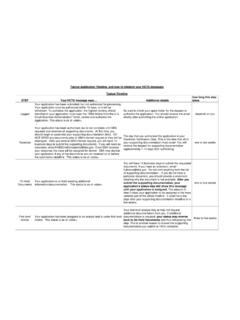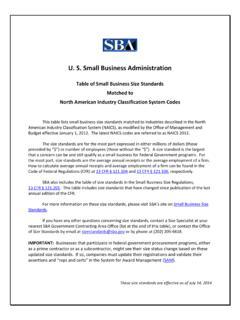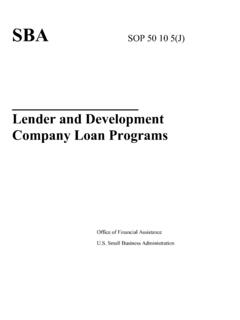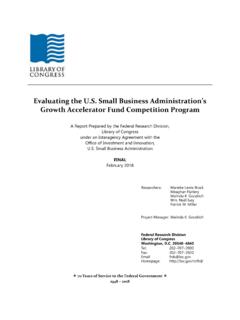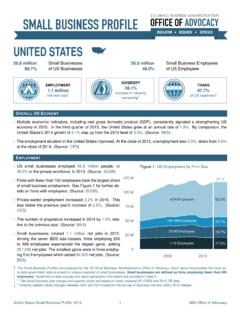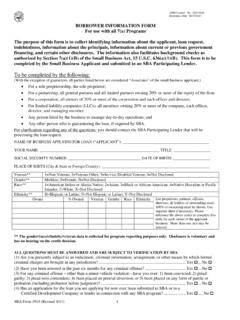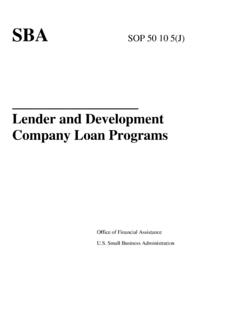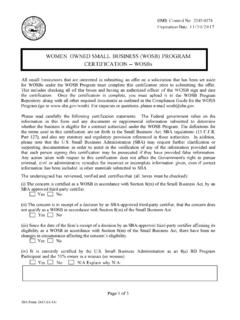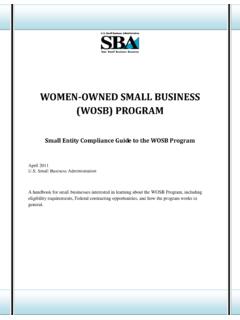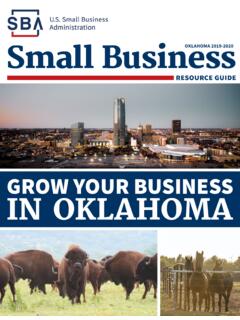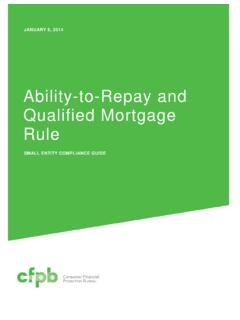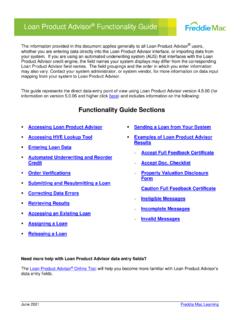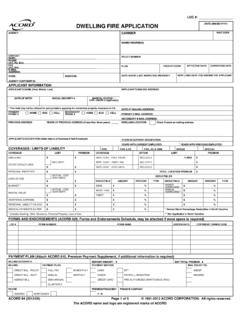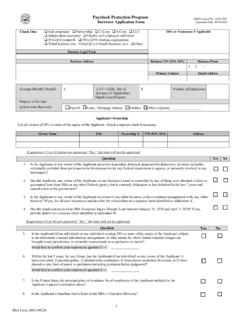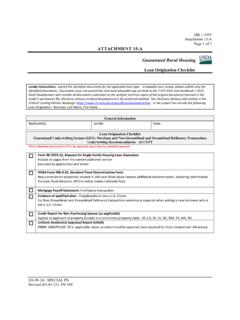Transcription of Underwriting and Cash Flow - Small Business Administration
1 Underwriting and Cash Flow April 16, 2019 @ 11 Eastern To listen by phone, dial 1-877-369-5243 then enter access code: 0931758## For technical assistance, contact the AT&T Helpdesk at 888-796-6118 Underwriting and Cash Flow Ray Chiamulera, Radar Lender Services Mary Wamsley, Strategic Banking Partners Chuck Evans, Capital Growth Solutions We would like to thank Mary, Ray and Chuck for their time and providing information regarding their experience on SBA lending programs from their perspective. All opinions, conclusions, and/or recommendations expressed herein are those of the presenters and do not necessarily reflect the views of the SBA. Co-sponsorship Authorization: #19-0390-30. SBA s participation in this cosponsored activity is not an endorsement of the views, opinions, products or services of any cosponsor or other person or entity.
2 All SBA programs and services are extended to the public on a nondiscriminatory basis. 3 SBA Underwriting Requirements The SBA SOP 50 10 5(K) states: Lenders must analyze each application in a commercially reasonable manner, consistent with prudent lending standards. The cash flow of the Small Business Applicant is the primary source of repayment, not the liquidation of collateral. Thus, if the lender s financial analysis demonstrates that the Small Business Applicant lacks reasonable assurance of repayment in a timely manner from the cash flow of the Business , the loan request must be declined, regardless of the collateral available or outside sources of cash. 4 SBA U/W Requirements - Three Categories (a) Small Loans - $350,000 or under (except Express) Credit Score (SOP 50 10 5(K), pages 182 to 185) (a) Loans $350,000 to $5 million (SOP 50 10 5(K) pages 178 to 182) Calculate the Debt Service Coverage (DSC), SBA has a rule Express (SOP 50 10 5(K) pages 187 and 190) 5 Underwriting Requirements-Analyzing Credit Detail Sources & Uses Collateral Discussion Discuss and verify Equity Injection Balance Sheet Analysis (pro forma or existing) Adequacy of Working Capital Ratio Analysis (compared to industry Current Ratio; Debt to TNW; etc.)
3 Reasonable assurance of repayment through analysis of historic or projected cash flow (acceptable credit score for loans up to $350,000 is sufficient to meet this requirement) 6 Underwriting Requirements Standards to Follow History of Business Description of management team Owner/Guarantor Analysis Life Insurance discussion Affect of any affiliates Lender rationale for recommending loan for approval 7 SBA Specific Credit Memo Requirements Eligibility of Borrower Eligibility of Use of Proceeds Credit Elsewhere Test Verification of tax returns (tax transcripts) Discussion of Previous Government Debt (SBA, FHA, VA, Student loans, etc.) 8 Use of Proceeds The SBA requires the Lender outline in detail what the loan funds will be used for: UseBank LoanBorrower Equity*Other Equity SourcesTotalEligible MaturityLand Purchase$0$0$0$0 25 Real Estate Purchase$0$0$0$0 25 Real Estate Construction$0$0$0$0 25 Construction Contingency (10%)$0$0$0$0 25 Interim Interest$0$0$0$0 10 Equipment Purchase$0$0$0$0 10 Leasehold Improvements$0$0$0$0 10 Business Acquisition$0$0$0$0 10 Refinance debt$0$0$0$0 10 Included Misc.
4 Costs detailed below:$0$0$0$0 10 Guaranty Fee$0$0$0$010 Total$0$0$0$09 Collateral SBA considers a loan as fully-secured if the lender has taken security interests in all available fixed assets with a combined net book value as adjusted below up to the loan amount. For 7(a) loans, the term fixed assets means real estate, including land and structures, machinery and equipment owned by the Business or an EPC. Equipment (75% New; 50% Used or 80% of the Orderly Liquidation Value ) Commercial Real Estate (85%) Residential Real Estate (85%) SBA does not require a lien on a personal real estate if there is not at least 25% equity. All Business Assets (10% Furniture, Fixtures, A/R, Inventory, etc.) For Lines of Credit (up to 85% of A/R and 50% of Inventory) 10 Equity Injection/Capital Start-Up Business At a minimum, SBA considers an equity injection of at least ten (10) percent of the total project costs necessary to operate on a sound financial basis.
5 SBA considers a start-up to be a Business that has been operating for less than 12 months. Change of Ownership SBA considered equity injection of at least ten (10) percent of the total project costs necessary for a complete change of ownership transaction. Seller may contribute up to five (5) percent of the required ten (10) percent. The seller note must be in full standby for the life of the loan. With a change of ownership between existing owners, 10% equity injection is not required if: (i) the remaining owner has been actively involved in the Business for at least 24 months prior to the change of ownership (lender must obtain borrower certificate to this effect and note it in the credit memo); and (ii) balance sheet reflects debt to worth ratio of not >9:1 prior to the change of ownership (otherwise, 10% equity is required).
6 11 Balance Sheet & Ratio Analysis Pro Forma Balance Sheet (after loan has been made) or, Current balance sheet adjusted for all changes in assets and liabilities as a result of the loan, other debt, required equity and use of proceeds Ratio Calculations (based on Pro Forma Balance Sheet and historic and projected income statement) Current Ratio Debt/Tangible Net Worth A/R, Inventory and A/P Turnover Any other ratios lender considers significant 12 Working Capital Positive Working capital is essential for the company to meet its continuous operational needs. (Current assets are the most liquid of the assets, meaning they are cash or can be quickly converted to cash. Current liabilities are any obligations due within one year) The lender must address the adequacy of the Small Business applicants working capital position.
7 If the lender s analysis shows the working capital is inadequate, the lender must the Small Business applicant to provide an explanation of where the working capital will come from, or lender should provide sufficient funds in the SBA loan to support adequate working capital 13 Debt Service Coverage Ratios Applicant s debt service coverage ratio (OCF/DS) must be equal to or greater than on a historical and/or projected cash flow basis and 1:1 on a global basis. OFC Operating Cash Flow = EBITDA DS Debt Service = the future required principal and interest payments on all Business debt inclusive of new SBA loan proceeds. 14 Tools Required to determine Cash Flow Most recent three years complete Tax Returns for the subject Business and all affiliates Most recent three years financial statements if the tax returns are not reflective of the Business being financed (acquisition of a division or territory of a larger company)
8 Financial statements from the most recent quarter end of the subject Business , includes P&L and Balance Sheet and all affiliates Business Debt Schedule of the subject Business and all affiliates Projections for the subject Business , if applicable Personal Financial Statement of all guarantors Personal credit Reports of all guarantors Last two years of personal tax returns for all guarantors 15 Build the Foundation Business Analysis Before you can perform a Global Debt Service Analysis, you must perform Debt Service Analysis on the individual businesses associated with the deal. Spread each affiliate and the subject company separately using their respective financial information and debt schedules Make standard adjustments to OCF Non-recurring rent payments in real estate purchases Owner s salary addback and/or owner s draw Explain any non-standard adjustments to your analysis Other non-recurring or one-time expenses Unfunded Capital Expenditures Non-recurring income 16 Build the foundation Personal Analysis Before you can perform a Global Debt Service Analysis, you must perform Debt Service Analysis on the individual businesses associated with the deal.
9 Your next step is to determine the personal income sources and expense. There are no specific rules in how you determine the personal cash needs of the individual guarantors, but it needs to be reasonable and explained. Compare the PFS to the Personal Credit Report to determine all household debt Review Personal Tax Returns for any rental income and expenses Schedule C for sole proprietorship income Schedule E for potential affiliates Review Personal Credit Report for all debt and repayment terms 17 Personal Budget Analysis Below is the analysis Radar Lender Services uses to determine how much draw is required from the subject Business . You do not have to use this analysis, but you need to show and explain how you determined you draw requirement.
10 MonthlyAnnualMonthlyAnnualIncomeExpenses Required Draw$0$0 Personal Mortgage (P&I)$0$0 Gross Salary-Principal$0$0 Rental Property Mortgage (P&I)$0$0 Gross Salary-Spouse$0$0 Rental Property Expenses$0$0 Gross Rental Income$0$0 Auto/Installment Loans$0$0 Interest Income$0$0 Revolving Credit$0$0 Alimony$0$0 Child Support/Alimony$0$0 Other Income$0$0 Living Expenses ($400/person)1$0$0 Total Income$0$0 Property Taxes (last actual)$0$0 Income Taxes$0$0 Misc. (5% of Total Income)$0$0 Total Expenses$0$0 Net Discretionary Income$0$0 Personal Budget Analysis: Borrower Name: _____18 Personal Financial Needs Eliminate debts from your analysis that will payoff within the next 6-12 months (excluding balloon notes) Estimate personal taxes based on draw requirements Ask about alimony and/or child support payments Assume student loans will need to be paid off and won t be on deferment forever 19 DSCR Chart TypeTax ReturnTax ReturnTax ReturnInterimProjectionPeriod Ending12/31/201612/31/201712/31/20183/31 /2019 Year 1 Months121212312 Revenue$0$0$0$0$0 Net Income$0$0$0$0$0 + Rent$0$0$0$0$0 + Interest$0$0$0$0$0 + Depreciation/Amortization$0$0$0$0$0 + Officer's Salary$0$0$0$0$0 +Other Addback.
